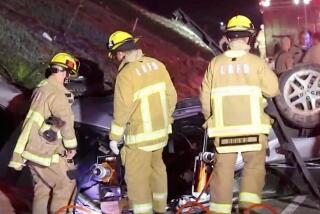Traffic Slows Down When Advisory Sign Lights Up
LAKE FOREST â As if motorists needed another obstacle to delay their commute, an electronic traffic advisory sign that had previously offered a blank stare to southbound drivers on Interstate 5 suddenly came to life one afternoon between El Toro Road and Alicia Parkway.
Gawking motorists, unaccustomed to seeing anything but a dark screen, slowed down to read the four-word message, causing a lengthy backup on all lanes.
âThis is a test,â said the advisory that burned brightly on the matrix screen.
Having read the announcement, drivers continued on their way, some reaching speeds of up to 70 m.p.h. by the time they reached the La Paz Road exit. Until then, southbound traffic barely moved between the killer El Toro âYâ and Alicia Parkway.
âThe signs are activated when something happens that impacts the freeway, or when theyâre being tested,â said Joe Hecker, the Caltrans district chief for traffic operations in Orange County. âOtherwise, we donât normally activate the signs because it creates congestion when people slow down to read them.â
Although they have been familiar sights on Los Angeles-area freeways since the early 1970s, electronic advisory signs are recent additions to Orange County highways. Today, there are 21 traffic signs strategically placed on all major freeways in the county, with another 12 scheduled to be operating by January, Hecker said.
Local California Department of Transportation officials say the growing need for the signs is further proof that freeway congestion is a major problem in Orange County.
Joe El-Harake, a traffic operations analyst for Caltrans, said the average number of cars using Orange County freeways a day increased 250% between 1966 and 1986. The national average for the same period was 74%, he said.
The number of motorists using roadways in South County increased 750% during the same time, he added, while on the Riverside Freeway daily traffic doubled between 1981 and 1987.
According to Caltrans statistics, traffic engineers in 1966 counted about 58,000 vehicles per month at what was then the beginning of the Santa Ana Freeway and the junction of the yet-to-be-built San Diego Freeway. By 1992, that figure had jumped to 313,000 vehicles per month at the intersection of the two freeways.
Caltrans officials use sophisticated technology, which they call âTransportation Systems Elements.â They include electronic sensors, ramp meters and closed-circuit television to keep jammed freeways moving.
The sensors monitor the speed and number of cars on the freeway, and the cameras help officials at Caltrans headquarters in Santa Ana zoom in on a freeway problem to determine the best solution for it.
âThe electronic signs are one of the most important elements in our system,â El-Harake said. âThe signs are especially efficient when we decide how to respond to an incident. We put the message on the screen and the public can make intelligent decisions on how to react, as to alternate routes or simply getting off the freeway and getting back on up the road.â
Hecker said that Caltrans policy is to activate the signs only when âsomething, an accident or vehicle breakdown, activates a freeway lane closure or when we have to shut down a freeway. Time is the key element. We try to activate the signs as soon as possible after a major freeway incident.â
Hecker said, however, that the signs are not always activated when there is massive congestion because the Caltrans office has not yet received information about a problem.
Caltrans officials say each freeway advisory sign costs about $140,000 and creates an unavoidable problem when first tested.
âThe sign on I-5 is a perfect example of this. We take a risk every time we test a new sign,â Hecker said. âIn order for Caltrans to buy the sign, we have to make sure that it works. The only way to make sure itâs working properly is to test it. Even when we show that itâs only a test, people slow down to look.â
More to Read
Sign up for Essential California
The most important California stories and recommendations in your inbox every morning.
You may occasionally receive promotional content from the Los Angeles Times.










